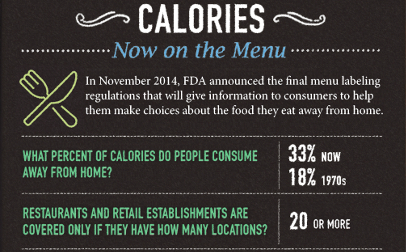Ahead of the effective date for those new, long-awaited menu labeling regulations, which is May 7, 2018, the U.S. Food and Drug Administration is out with some non-binding “guidance” to help with implementation. FDA Commissioner Scott Gottlieb rolled out the guidance this week, using the occasion to underscore his commitment to improving nutritional information.
 “As someone who enjoys eating out with my family and picking up the occasional take-out meal, I – like many Americans – want to know what’s in the food I eat,” Gottlieb said.
“As someone who enjoys eating out with my family and picking up the occasional take-out meal, I – like many Americans – want to know what’s in the food I eat,” Gottlieb said.
“As FDA Commissioner, I also know that more people are eating meals away from home, and our diets are increasingly comprised of foods we get from restaurants or take-out meals. FDA is committed to leveraging nutrition to enhance health and reduce disease, and the agency soon will be announcing a broader policy effort in this area.”
In addition to menu labeling, Gottlieb said improvement to the “Nutrition Facts” panel on food packages and additional consumer education policies are in the works. His comments this week are consistent with his previous statements supportive of nutrition information initiatives since he was named to head FDA by President Donald J. Trump.
The menu labeling requirements are only mandatory for restaurants and retail outlets with 20 or more locations. Smaller operations can “opt-in” to the federal program. Most effected restaurants and retailers were ready to implement new menu labeling in May this year, but FDA put the brakes on for more comments, especially from pizza and movie chains.
The National Restaurant Association’s Cicely Simpson said her organization is pleased FDA took into account comments from the restaurant industry and will that the organization will “continue to work with the FDA to successfully implement federal menu labeling by May 2018.” Simpson is NRA’s executive vice president of public affairs.
Restaurants and retailers operating in multiple locations and states tend to favor the federal program to avoid the added expense that can come with duplication. Gottlieb says it is also important that the calorie counts be “consistently available.”
 “At a time when more than a third of U.S. adults are obese and more people are trying to make healthier lifestyle decisions, we know making informed choices about our diets has the potential to save and improve lives,” Gottlieb says.
“At a time when more than a third of U.S. adults are obese and more people are trying to make healthier lifestyle decisions, we know making informed choices about our diets has the potential to save and improve lives,” Gottlieb says.
“For instance, it can help to reduce the risk of many obesity-related conditions, such as heart disease, stroke, diabetes and certain types of cancer. This is why we’re seizing the opportunity to empower Americans to more carefully consider their food choices by providing access to uniform and consistent calorie and nutrition information for foods on display, menus and menu boards.”
The FDA Commissioner claims the agency is “being pragmatic and not overly burdensome to restaurants and similar retail food establishments.” He says the required menu labeling “can be efficiently implemented by restaurants and similar retail food establishments and sustained for the long run.”
FDA first proposed a menu labeling rule in 2011. Gottlieb said he is committed to the May 7, 2018, implementation date. He said the new draft guidance is in direct response to the comments FDA received on the menu labeling regulation.
In recent comments, some store owners asked us whether posters, billboards, coupon mailings, and other marketing materials would meet FDA’s definition of a menu, which would require owners to include calorie information. The new draft guidance explains that such materials are not considered menus under the regulation and do not require calorie counts, Gottlieb said.
The draft guidance also responds to questions about self-service buffets, beverage stations and pizza menu boards that offering choices with thousands of combinations. In addition to providing examples of how those situations can be addressed, the FDA draft guidance makes other clarifications and accommodations to make sure implementation of the new menu labeling requirements goes forward on time and succeeds for the long-term.
(To sign up for a free subscription to Food Safety News, click here.)
